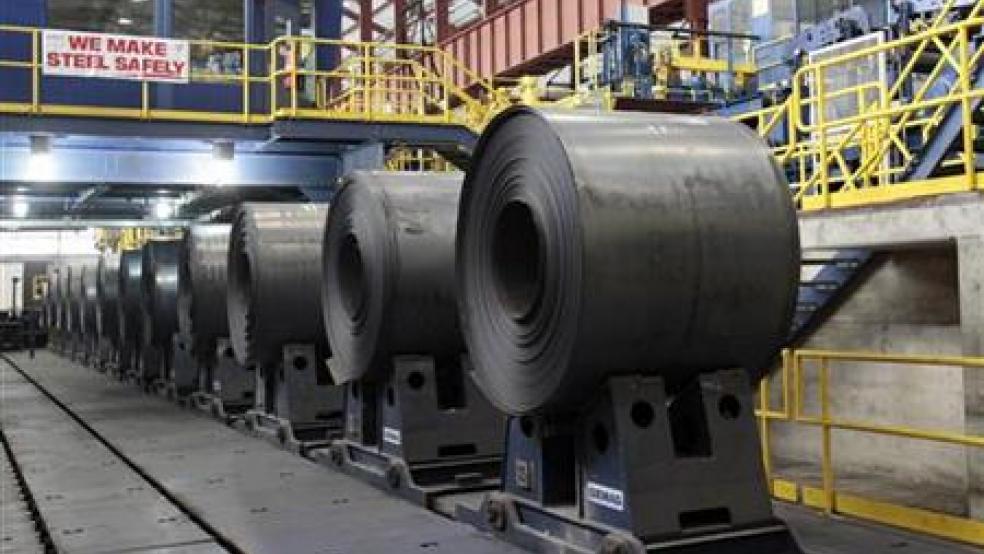NEW YORK (Reuters) - Manufacturing shrank in June for the first time in nearly three years as new orders plummeted, according to one measure of the sector that provided a stark sign of the economic recovery's slowdown.
The Institute for Supply Management said on Monday its index of national factory activity fell to 49.7 from 53.5 the month before, missing expectations of 52.0, according to a Reuters poll of economists, and below even the lowest forecast.
It was the first time since July 2009 that the index has fallen below the 50 mark that separates expansion from contraction. That was shortly after the U.S. economy emerged from recession.
Manufacturing has been one of the drivers of the U.S. economic recovery, which now appears to be losing momentum over fears about the euro zone's debt crisis, a slowdown in China and uncertainty over domestic fiscal policy.
"Clearly this is the biggest sign yet that the U.S. is catching the slowdown that is well under way in Europe and China," said Paul Dales, senior U.S. economist at Capital Economics in London.
Dales said the report is consistent with an economy that is growing at an annualized rate of a little below 1 percent after 1.9 percent growth in the first quarter, dismissing talk that the number signaled a new U.S. recession was coming.
A reading below 47 would be consistent with another recession, Dales said.
The ISM report painted a more dour picture of manufacturing than a survey released earlier on Monday from Markit, which showed the sector still grew in June, albeit at its slowest rate in 18 months.
WEAK ISM RAISES ODDS OF AUGUST STIMULUS
Still, analysts said the ISM report increased the odds the Federal Reserve will step in with a third round of bond buying - known as quantitative easing, or QE3 - to prop up the economy.
"Both growth and inflation are slowing, which puts the Fed firmly in the game. There is a very good chance of QE3 at the August Fed meeting," said Jacob Oubina, senior U.S. economist at RBC Capital Markets in New York.
The Federal Open Market Committee's next meeting is set for July 31-August1.
The data initially pushed Wall Street lower, but the S&P 500 and Nasdaq managed to finish the day higher as investors speculated more stimulus from the Fed would be forthcoming. The Dow industrials index finished slightly lower.
But the data hit other markets with Treasuries prices rising on safe-haven buying and the euro falling against the dollar.
The forward-looking new orders component sank in June to 47.8, its lowest since April 2009, from 60.1 in May. It was the largest monthly drop since October 2001, following the September 11 attacks, ISM said.
Exports fell to 47.5 in June from May's 53.5 and ISM said companies expressed concerns that "demand may be softening due to uncertainties in the economies in Europe and China."
The employment gauge held up better, dipping to 56.6 in June from 56.9 in May.
Investors will get a broader look at the labor market on Friday when the U.S. nonfarm payrolls report for June will be released.
Until Monday's report, U.S. manufacturing had held up better than similar sectors overseas, which have already shown signs of deteriorating. Euro-zone manufacturing took another hit in June, data showed on Monday, while China and Japan saw orders from abroad fall.
CONSTRUCTION SPENDING JUMPS
A separate report on Monday showed U.S. construction spending rose to its highest level in nearly 2-1/2 years in May as investment in residential and federal government projects gained.
Construction spending increased 0.9 percent to an annual rate of $830 billion, the highest level since December 2009, following April's upwardly revised gain of 0.6 percent.
The economy is facing a "fiscal cliff" of $4 trillion in tax hikes and spending cuts due to kick in at the end of the year unless lawmakers act to delay or offset them, which could prompt businesses to sit on the sidelines for now.
"Businesses have become a bit more cautious about their second-half plans and may be deferring major decisions until the dust from the euro zone financial crisis and the fiscal cliff in the U.S. clears a bit," said David Resler, chief economist at Nomura Securities in New York.
The uncertainty over fiscal policy is a rising factor for small businesses, according to a survey by Vistage International, which represents chief executives of small companies. Firms lowered their hiring expectations in the second quarter as confidence in the economy soured.
But lending to small businesses rose in May to its highest level this year, a sign economic growth has not dropped off.
The Thomson Reuters/PayNet Small Business Lending Index, which measures the overall volume of financing to small U.S. companies, rose to 108.4 in May from 96.6 in April. The gain reversed most of the declines of the previous four months.
There were also more signs that the long-struggling housing market is finally stabilizing as home prices rose in May, according to a data analysis firm.
CoreLogic's home price index gained 1.8 percent in May from April and was up 2.0 percent from a year earlier.
Excluding distressed sales, prices fared even better, gaining 2.3 percent in May and 2.7 percent from a year ago. Homeowners in danger of foreclosure, or in "distress," often sell their homes at a significantly reduced price.
(Additional reporting by Julie Haviv in New York and Lucia Mutikani in Washington; Editing by Leslie Gevirtz)


